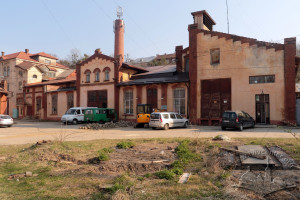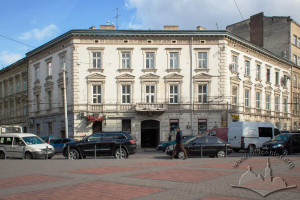Gabriel Sokolnicki ID: 268
Gabriel Sokolnicki ID: 268
1877-1975
An electrical engineer, an entrepreneur, an owner and shareholder of several electric installation companies, who also was rector and, for many years, professor of the Lviv Polytechnic. Sokolnicki implemented a number of projects connected with electrification of cities and industrial enterprises in interwar Poland.
Professor Dzieślewski immediately involved his young capable assistant in practical work. Józef Tomicki, the director of the Municipal Electrical Facilities, recruited Dzieślewski and Fidler, both professors of the Lviv Polytechnic, and Sokolnicki, a department assistant, as experts to the commission controlling the trial start of a new Siemens & Halske generator at the electric plant on Sakharova street.
From 1903 till 1913 Sokolnicki was the co-owner and technical director of the Sokolnicki & Wiśniewski electric installation company. The company had its factory in Lviv on Zaliznychna (then Na Błonie) street 38. Its office was located on Słowackiego street 18 and the production shop was located on Akademicka street 18 (now Shevchenka boulevard). On 19 January 1911 the Sokolnicki & Wisniewski company was granted permission to open a branch in Krakow on Bracka street 8. In 1938 the directorate, technical department and sales department were located on Stavropihiyska (then Dominikańska) street 3.
The company manufactured its own electrical meters and ammeters, developed and implemented power supply projects. The firm was not engaged in small projects such as installation of wiring in separate apartments, but undertook large-scale and responsible tasks, for example, electrification of towns or industrial enterprises. In the course of these works, Sokolnicki gained important experience in the new, then unknown energy industry.
In March 1912, under Gabriel Sokolnicki’s project and supervision, a power plant and an electric grid were built and put into operation in the towns of Nowy Sącz and Jasło.
In 1913 Gabriel Sokolnicki was appointed to the position of private associate professor at the Lviv Polytechnic with a series of lectures entitled "The Projects and Estimates of Electrical Installations" and "The Electrotechnical Encyclopaedia." At the same time he organized a firm named "Sokolnicki — An Advice and Electrical Engineering Projects Bureau" (pol. Biuro Porad i Projektów Elektrotechnicznych), and in 1916 received a government license and the title of "private engineer." During these years, he developed a project for the construction of a power plant and power grids in Krosno, Rzeszów, Zakopane, as well as a project for converting part of Lviv’s DC power grid to AC. In 1917 Sokolnicki designed a project for the transmission of electricity from Drohobych (from a private power plant at the Galicja oil refinery) to oil fields in Boryslav using a voltage of 35 kV. This was the first power line with such voltage in Galicia.
Gabriel Sokolnicki's interests were not limited to electrification. As researched by Barbara Gierszewska, in 1913 Sokolnicki was one of the co-owners of a company named "Polskie Towarzystwo Kinetofonu Edisona. Spółka z o.p." The company received an exclusive license for kinetophones in Galicia and Bukovyna, which allowed for simultaneous combination of picture and sound when screening a movie.
Sokolnicki advocated the idea of constructing powerful electric plants based on explored energy resources, such as, for example, coal deposits or water reserves. After all, the construction of local power plants in cities inevitably faced the problem of transporting large volumes of fuel to them and environmental consequences of burning it in residential agglomerations.
Sokolnicki was one of the initiators of the construction of a powerful electric plant based on oil-well gas in Boryslav. In 1917 he shared in the United Power Ltd. company (Sp. z o.p. "Elektrownia Związkowa"), created for the construction of this power plant. At the first meeting the shareholders elected him as executive director. First, they bought an existing power plant from the “Abraham Sobel i s-ka” company and later purchased a plot to build a new one. It was also planned to build a large peat power plant: with this in view, they bought peat deposits in Strutyn, near the town of Dolyna. Two 100 kV power lines were designed from electric plants in Boryslav and Dolyna to Stryy and Lviv. All these plans were cancelled by the First World War.
The post-war devastation forced the company to agree to the construction of the power plant in Boryslav by the Premier, a private French oil production company, but Sokolnicki and his allies secured that the power plant was not limited to producing electricity for the company’s own needs limited to oil production, but became a regional one. In 1924, with the participation of Sokolnicki, a joint stock company named the Subcarpathian Electric Society (pol. Podkarpackie Towarzystwo Elektryczne S.A. we Lwowie) was formed. A few years later, the company purchased the Premier power plant and began construction of a 15kV power line from the regional power plant in Boryslav to the municipal electric grids of Drohobych, Stryy, Truskavets, and Sambir.
In 1925 Gabriel Sokolnicki designed a project to convert a power plant and an electric grid in the town of Sambir, built in 1908, from direct current to alternating current. The generator capacity increased by five. In 1930, at the suggestion of Sokolnicki, the Sambir town council signed an agreement with the Subcarpathian Electric Society for the wholesale supply of electricity from the power plant in Boryslav.
Along with his teaching work, Gabriel Sokolnicki developed projects for restructuring power plants and grids in Zhovkva, Przemysl, and Sanok. He designed and built power plants and grids in Rava Ruska and Khodoriv, as well as new power lines and subplants in Drohobych, Stanislaviv, Stryy, Nadvirna, Kremenets, Stary Sambir, Krakow, Przemysl, Jarosław, and Tarnów. The implementation of some projects was managed by him personally.
At the same time, Sokolnicki headed the department of electrical lighting (later electrical equipment), and in 1928-1929 was the dean of the mechanical faculty.
In 1931-1932 Gabriel Sokolnicki was elected rector of the Lviv Polytechnic. While performing the rectorial functions, Sokolnicki developed a large-scale electrification project for the Lviv province. According to the project, with his seal reading "Gabriel Sokolnicki, professor of Lviv Polytechnic, private government-licensed electrical engineer" attached, a 9-year governmental program for the construction of 30 kV power lines from the Lviv electric plant to Zhovkva, Yavoriv, Rava-Ruska, Pustomyty, Horodok and other towns was approved, thus allowing to get rid of unprofitable local power plants.
While being rector of the Polytechnic, Sokolnicki had to face significant ethical challenges. In 1932, anti-Semitic attacks began from part of the students supporting national democratic views who declared a strike and did not allow Jews to study. Sokolnicki's reaction was decisive and firm. On May 23, he announced a temporary closing of the Polytechnic. In an interview with the Polish state telegraph agency when asked by a journalist when the Polytechnic would reopen, the rector said as follows: "In my opinion, the sanctuary of science has been profaned. I consider the possibility of taking forceful actions myself to suppress the arbitrariness and further discrediting academic autonomy. That is why I don’t know when I will allow to resume studies."
In the interwar period, professor Sokolnicki lived on Rusovykh (then Wiśniowieckich) street 1. Sokolnicki survived the tragic events of the Second World War, the murder of Lviv scientists, and managed the department in the postwar years, even at a very advanced age.
Despite the fact that after the war the majority of Lviv’s Polish population had to leave the city and move to Poland (within the nation’s newly formed borders), Gabriel Sokolnicki remained. In 1944-1961 he headed the department of power plants, grids and systems, and in 1961-1964 the department of power plants.
In his memoirs about Sokolnicki, professor Rostyslav Kurendash, a younger colleague, mentioned the latter’s noble posture and manners as well as the sense of humour. He also mentioned a curious and courageous action of the professor. Already in Soviet times, at the celebration of his anniversary, Gabriel Sokolnicki noted that he "had been a capitalist with his own electrical engineering company before the war, so under socialism, as a former exploiter, he might not deserve such respect." For the surprised Soviet curators, there was nothing else left to do but to turn a deaf ear to what was said.
In 1965, at a farewell party on his retirement, Sokolnicki made everyone laugh for a long time. "Once, when I asked about a longtime friend of mine who worked for the Siemens in Berlin, I heard that he was still in the company, but just as an appendix: he does not perform any function and only hurts sometimes. I don’t want to be spoken about like this, that’s why I’m retiring."
Another interesting story once told by Sokolnicki about his past was mentioned by Anton Malinovsky, a professor of the Lviv Polytechnic. "It was a long time ago that I was commissioned for the electrification of a landlord’s estate with a palace and a folwark (perhaps it was in Pidkamin, where, as mentioned in the Czasopismo Techniczne, a project was designed and electric installation works were carried out by Sokolnicki's company before the First World War — note by the author). The customer sent me a floor plan of the house, where he had indicated in detail the number of lamps he needed in the habitable rooms, while in the utility rooms only short marks were indicated: 1 dz, 2 dz, etc. I was very intrigued by these marks so I went there myself. It turned out that there were winnowers in these rooms for separating grain from chaff, and 1 dz, 2 dz stood for one or two dziewcząt (Polish for “girls”), who operated them. So I learned that, in addition to joules, kilowatts and horsepower, work can still be measured in girl power."
Gabriel Sokolnicki died in 1975 at the age of 98 and was buried at the cemetery in Briukhovychi, where he lived since the second half of the 1930s.
Related buildings and spaces
Organizations
Sources
- Державний архів Львівської області (ДАЛО) 1/11/1161.
- ДАЛО 1/18/715.
- ДАЛО 1/18/1873.
- ДАЛО 1/36/1508.
- ДАЛО 2/26/216.
- ДАЛО 3/1/4673.
- ДАЛО 3/1/5095.
- ДАЛО 3/1/5350.
- ДАЛО 27/4/340.
- ДАЛО 27/4/600.
- Центральний державний історичний архів України у Львові (ЦДІАЛ) 224/1/1.
- ЦДІАЛ 224/1/89, 98, 100,101, 121, 134, 136, 198.
- ЦДІАЛ 726/1/798.
- "Oświadczenie rektora Sokolnickiego w sprawie zawieszenia wykładów", Gazeta Lwowska, 26.5.1932.
- Gabriel Sokolnicki, "Gospodarka w elektrowniach publicznych bez odpisów", Codzienna Gazeta Hadlowa, 7-8. 03. 1937.
- Микола Буцко, "Ґабриель Сокольницький", Львівський політехнік, 1993.
- Ростислав Курендаш, "Піонер електрифікації Західної України", Львівський політехнік, 4.10.1995.
- Gabriel Sokolnicki, Elektrownia miejska w Nowym Sączu (Lwów, 1914).
- Zbysław Popławski, Dzieje Politechniki Lwowskiej. 1844-1945 (Wrocław, Warszawa, Kraków, 1992).
- Микола Буцко, Відомі вчені Державного університету "Львівська Політехніка" 1844 – 1994 (Львів, 1994).
- Національний університет "Львівська Політехніка, (Київ, 2009).
- Jerzy Hickiewicz, "Gabriel Sokolnicki(1877-1975)", Polacy zasłużeni dla elektryki (Warszawa- Gliwice – Opole, 2009).
- Jerzy Hickiewicz, Gabriel Sokolnicki (1877-1975), Roman Dzieślewski (Warszawa-Rzeszów-Tarnów- Gliwice – Opole, 2014).
- Andrij Kryżaniwskij, "Prąd ształy czy przemienny. Jak to było na początku elektryfikacji Lwowa", Zeszyty Naukowe Wydziału Elektrotechniki i Automatyki Politechniki Gdańskiej, 2015, Nr. 43.








